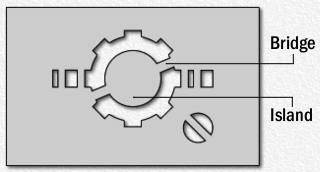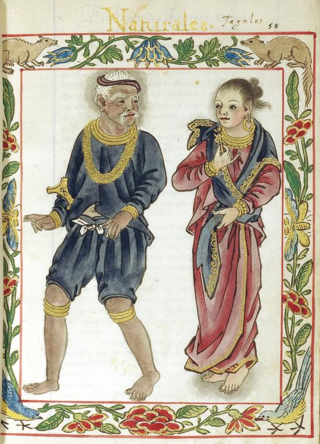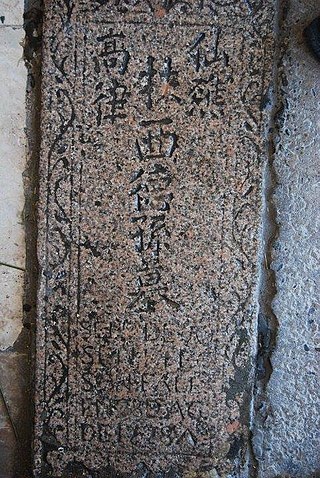
A mimeograph machine was a low-cost duplicating machine that worked by forcing ink through a stencil onto paper. The process was called mimeography, and a copy made by the process was a mimeograph.

An envelope is a common packaging item, usually made of thin, flat material. It is designed to contain a flat object, such as a letter or card.

Chad refers to fragments sometimes created when holes are made in a paper, card or similar synthetic materials, such as computer punched tape or punched cards. The word "chad" has been used both as a mass noun and as a countable noun.

Bulacan, officially the Province of Bulacan, is a province in the Philippines located in the Central Luzon region. Its capital is the city of Malolos. Bulacan was established on August 15, 1578, and part of the Metro Luzon Urban Beltway Super Region. This province is a part of the Greater Manila Area.

The art of paper cutting in China may date back to the 2nd century CE, when paper was invented by Cai Lun, a court official of the Eastern Han dynasty.

Stencilling produces an image or pattern on a surface by applying pigment to a surface through an intermediate object, with designed holes in the intermediate object. The holes allow the pigment to reach only some parts of the surface creating the design. The stencil is both the resulting image or pattern and the intermediate object; the context in which stencil is used makes clear which meaning is intended. In practice, the (object) stencil is usually a thin sheet of material, such as paper, plastic, wood or metal, with letters or a design cut from it, used to produce the letters or design on an underlying surface by applying pigment through the cut-out holes in the material.

San Ildefonso, officially the Municipality of San Ildefonso is a municipality in the province of Bulacan, Philippines. According to the 2020 census, it has a population of 115,713 people.

Papel picado is a traditional Mexican decorative craft made by cutting elaborate designs into sheets of tissue paper. Papel picado is considered a Mexican folk art. The designs are commonly cut from as many as 40-50 colored tissue papers stacked together and using a guide or template, a small mallet, and chisels, creating as many as fifty banners at a time. Papel picado can also be made by folding tissue paper and using small, sharp scissors. Common themes include birds, floral designs, and skeletons. Papel picados are commonly displayed for both secular and religious occasions, such as Easter, Christmas, the Day of the Dead, as well as during weddings, quinceañeras, baptisms, and christenings. In Mexico, papel picados are often incorporated into the altars (ofrendas) during the Day of the Dead and are hung throughout the streets during holidays. In the streets of Mexico, papel picados are often strung together to create a banner that can either be hung across alleyways or displayed in the home.

The Tagalog people are an Austronesian ethnic group native to the Philippines, particularly the Metro Manila and Calabarzon regions and Marinduque province of southern Luzon, and comprise the majority in the provinces of Bulacan, Bataan, Nueva Ecija, Aurora, and Zambales in Central Luzon and the island of Mindoro.

Amate is a type of bark paper that has been manufactured in Mexico since the precontact times. It was used primarily to create codices.

Papercutting or paper cutting is the art of paper designs. Art has evolved all over the world to adapt to different cultural styles. One traditional distinction most styles share is that the designs are cut from a single sheet of paper as opposed to multiple adjoining sheets as in collage.

Carlos Antonio Santos-Viola was an architect in the Philippines. He is best known for designing and building churches for the Iglesia ni Cristo (INC) religious group.

Narcisa Buencamino-De León was a Filipino film producer and businesswoman.

San Salvador Huixcolotla is a town and municipality in the Mexican state of Puebla in southeastern Mexico that may be best known as the birthplace of papel picado. San Salvador is of Spanish origin and translates to "Holy Savior" and Huixcolotla is Nahuatl for "place of the curved spines".

Jewish paper cutting is a traditional form of Jewish folk art made by cutting figures and sentences in paper or parchment. It is connected with various customs and ceremonies, and associated with holidays and family life. Paper cuts often decorated ketubbot, Mizrahs, and ornaments for festive occasions. Paper cutting was practiced by Jewish communities in both Eastern Europe and North Africa and the Middle East for centuries and has seen a revival in modern times in Israel and elsewhere.

Pablo Ocampo Tecson was an officer in the Revolutionary Army serving under Gen. Gregorio del Pilar and a representative to the Malolos Congress. He was elected the Governor General of Bulacan immediately following the Philippine–American War. Tecson later served as Insular Secretary of the Philippine Bureau of Agriculture.

Pastillas, also known as pastillas de leche, refer to a type of milk-based confections that originated in the town of San Miguel in Bulacan, Philippines. From San Miguel, pastillas-making spread to other Philippine provinces such as Cagayan and Masbate.
Alberta Uitangcoy-Santos was the leader of The Women of Malolos, and is revered for her contributions to Philippine women's rights, the fight for Philippine independence, and a large part of the traditional cuisine of the city of Malolos, Bulacan, in the Philippines during the Spanish and American colonial periods. She is known as the matriarch of the Uitangcoy-Santos House, which has been declared a national heritage house by the National Historical Commission of the Philippines, and currently houses the Museum of the Women of Malolos which is now curated by her fifth-generation grandson, Carlo Herrera.

New Manila International Airport, also known as Bulacan International Airport, is an international airport under construction on the coastal areas of Bulakan, Bulacan, 35 km (22 mi) north of Manila, the capital of the Philippines. The project was proposed by the San Miguel Corporation (SMC) and is set to help decongest Ninoy Aquino International Airport (NAIA), the main gateway to the capital for air travelers.

Tecson/Ticzon is a Chinese Filipino surname.



















